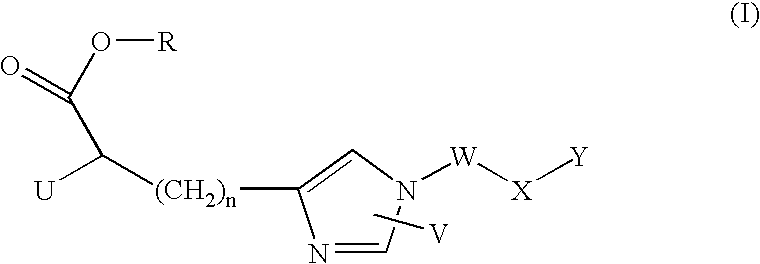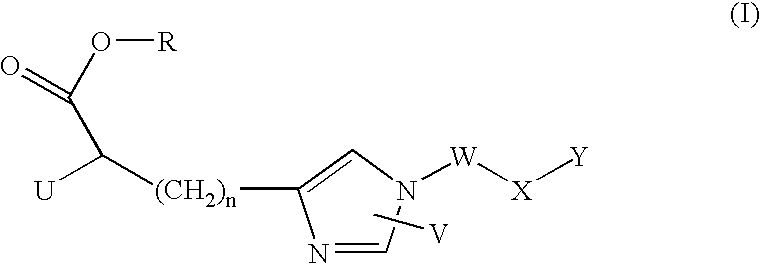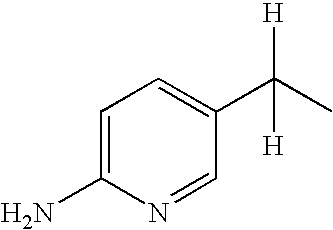Imidazole derivatives as inhibitors of tafia
a technology of tafia and derivatives, which is applied in the direction of drug compositions, extracellular fluid disorders, metabolic disorders, etc., can solve the problems of human serious pathological states and the risk of unwanted bleeding
- Summary
- Abstract
- Description
- Claims
- Application Information
AI Technical Summary
Problems solved by technology
Method used
Image
Examples
example 1
3-(6-Aminopyridin-3-yl)-2-{1-[5-(5-chlorothiophen-2-yl)isoxazol-3-ylmethyl]-1H-imidazol-4-yl}propionic acid
a) Methyl 3-(6-aminopyridin-3-yl)-2-{1-[5-(5-chlorothiophen-2-yl)isoxazol-3-ylmethyl]-1H-imidazol-4-yl}propionate trifluoroacetate
[0287]Under argon, 0.032 g (1.340 mmol) of sodium hydride was added to a solution of 0.300 g (1.218 mmol) of methyl 3-(6-aminopyridin-3-yl)-2-(1H-imidazol-4-yl)propionate in 5 ml of absolute dimethylformamide (DMF), and the mixture was stirred at RT for 30 min. 0.339 g (1.218 mmol) of 3-bromomethyl-5-(5-chlorothiophen-2-yl)isoxazole was then added, and the reaction mixture was stirred at RT for a further 3 h and then concentrated. The residue was purified by preparative HPLC. Freeze-dying of the fraction of value gave the title compound as the trifluoroacetic acid salt. Yield 0.450 g (66%).
[0288]LC / MS: Rt=1.17 min, [M+H]+=444 (method A).
b) 3-(6-Aminopyridin-3-yl)-2-{1-[5-(5-chlorothiophen-2-yl)isoxazol-3-ylmethyl]-1H-imidazol-4-yl}propionic acid
[0289...
example 2
3-(6-Aminopyridin-3-yl)-2-[1-(5-phenylisoxazol-3-ylmethyl)-1H-imidazol-4-yl]propionic acid
a) Methyl 3-(6-aminopyridin-3-yl)-2-[1-(5-phenylisoxazol-3-ylmethyl)-1H-imidazol-4-yl]propionate
[0291]Under argon, 0.041 g (1.624 mmol) of sodium hydride was added to a solution of 0.400 g (1.624 mmol) of methyl 3-(6-aminopyridin-3-yl)-2-(1H-imidazol-4-yl)propionate in 15 ml of absolute DMF, and the mixture was stirred at RT for 30 min. 0.387 g (1.624 mmol) of 3-bromomethyl-5-phenylisoxazole was then added, and the reaction mixture was stirred at RT for a further 3 h and then concentrated. The residue was taken up in ethyl acetate, washed with water, dried over Na2SO4 and concentrated. The crude product was chromatographed on silica gel (mobile phase dichloromethane / methanol / acetic acid / water 90:10:1:1). Freeze-dying of the fraction of value gave the title compound as the acetate. Yield. 0.600 g (80%).
[0292]LC / MS: Rt=1.1 min, [M+H]+=404 (method B).
b) 3-(6-Aminopyridin-3-yl)-2-[1-(5-phenylisoxaz...
example 3
3-(6-Aminopyridin-3-yl)-2-{1-[2-(5-chlorothiophen-2-yl)thiazol-5-ylmethyl]-1H-imidazol-4-yl}propionic acid
[0295]The title compound was obtained analogously to Example 2 as trifluoroacetic acid salt from 5-bromomethyl-2-(5-chlorothiophen-2-yl)thiazole.
[0296]LC / MS: Rt=1.03 min, [M+H]+=446, chloro pattern (method A). 1H-NMR (DMSO-d6, 500 MHz): δ [ppm]=13.8 (s, br, 1H), 8.65 (s, br, 1H), 8.02 (s, br, 2H), 7.98 (s, 1H), 7.72 (m, 2H), 7.58 (d, 1H), 7.45 (s, 1H), 7.21 (d, 1H), 6.85 (d, 1H), 5.61 (s, 2H), 4.03 (t, 1H), 3.12 (dd, 1H), 2.99 (dd, 1H).
PUM
| Property | Measurement | Unit |
|---|---|---|
| temperature | aaaaa | aaaaa |
| flow rate | aaaaa | aaaaa |
| flow rate | aaaaa | aaaaa |
Abstract
Description
Claims
Application Information
 Login to View More
Login to View More - R&D
- Intellectual Property
- Life Sciences
- Materials
- Tech Scout
- Unparalleled Data Quality
- Higher Quality Content
- 60% Fewer Hallucinations
Browse by: Latest US Patents, China's latest patents, Technical Efficacy Thesaurus, Application Domain, Technology Topic, Popular Technical Reports.
© 2025 PatSnap. All rights reserved.Legal|Privacy policy|Modern Slavery Act Transparency Statement|Sitemap|About US| Contact US: help@patsnap.com



